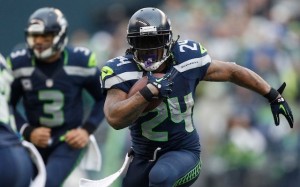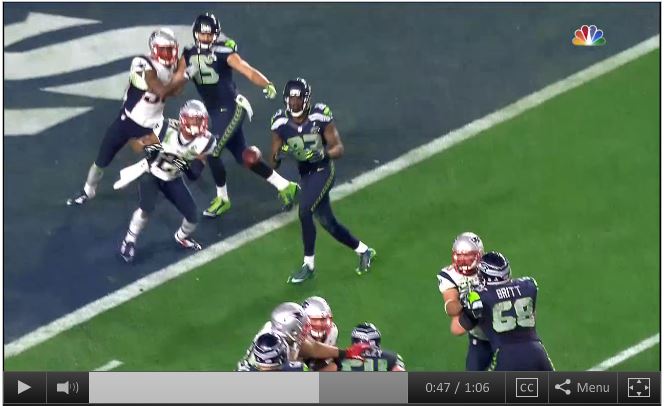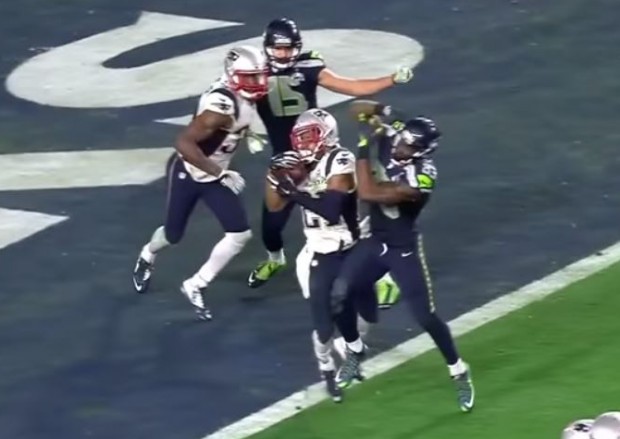3 PowerPoint Myths from a Master Storyteller
August 8, 2014PowerPoint Clip Art is Dead. Now What?
February 16, 2015This article has nothing to do with presentations. But if you know me, you’ll know you can count on me for 1) challenging sloppy thinking and 2) being data-based (example >).
With that said, let me state clearly: Seattle made the right call at the end of the Super Bowl.
With 26 seconds left in the game, and one timeout left, Seattle was on the one-yard line. They needed a touchdown to win. On second down and goal, they threw a quick pass which got intercepted by Malcolm Butler of the Patriots, ending the game and giving the Patriots the Super Bowl.
The internet erupted with criticism, calling it the “Worst Call in NFL History“. I’m going to show you it was the right call, using data.
Bottom line: with 26 seconds left you have time for 2 running plays. But if you want THREE chances at the end zone, at least one of those plays has to be a pass. And it’s best to try that pass on second down when the defense is expecting a run.
The Situation
With 26 seconds left, the Seahawks have to make a decision: run or pass? At first glance it seems obvious: you are just one yard away. Run it!
But if you don’t score on that play, it gets trickier. Because you have to use your last timeout to stop the clock at about 18 seconds. Now what? Run or pass? If you run and don’t get in, the clock keeps running down. You might not have time to line up for a fourth play. If you pass and it’s incomplete, the clock stops and gives you time for a fourth play.
So you don’t have time for 3 running plays. If you want 3 shots at the touchdown, at least one has to be a pass. So what do you do on 2nd down?
If you RUN
Marshawn Lynch is an amazing running back. But his stats aren’t good at the goal line. During the 2014 regular season, he ran the ball 5 times from the one-yard line and only scored once — a pitiful 20% success rate. If we look at his success rate from up to 3 yards away, he’s run the ball 11 times and gained at least one yard 7 times, and stopped for no gain or a loss 4 times (source). At best, we can say there’s a 7-in-11 chance Lynch scores the touchdown in this situation (63%). So if you run the ball with Lynch, your chances are
- 63% touchdown
- 36% stopped for no gain/loss
- 1.4% fumble
If you PASS
Russell Wilson completed 63% of his passes in 2014 and only 1.5% were intercepted. He’s only thrown from inside the 5-yard-line five times, and 3 were completed. Again, a 60% completion rate (source). So your chances if you throw:
- 63% touchdown
- 36% incomplete
- 1.5% interception
Now you see that Seattle has the same chance to win the game running or passing! But if they run and don’t get into the end zone, they have to burn their last timeout with about 18 seconds left. With no timeouts left, they either have to pass on third down, or run the ball and take their chances that Lynch can get a touchdown because they probably won’t have time to run another play on fourth down.
But if you pass it on 2nd down (as Seattle wisely chose) and the pass is incomplete, the clock stops automatically at 18 seconds and you still have your timeout! Now you face the same run/pass choice on third down. But you’re in a better position because with your timeout, you can leisurely run it twice. And the defense knows that.
The Real Problem
The real problem wasn’t the call. It was how the ball was thrown. Ideally, Wilson would throw the ball so it hits the receiver in the chest and the defender coming from behind has to go through the receiver’s back to get it. Instead, Wilson threw it in front of the receiver so he had to reach for it.
The receiver, Ricardo Lockette (83), was actually closer to the ball but waited for it to get to him. In fact, if you watch closely, it actually looks like Lockette slowed down toward the end of his run, possibly to avoid a collision with the charging defender (Lockette is known more for his blistering speed than his brute strength). In that case, Wilson’s throw was right on the money and would have hit him on the chest if he had maintained his full running speed.
Malcolm Butler (21), the defender on the play, showed amazing speed and determination to get to the ball first. And amazing smarts to know it was a pick play and where the ball was going to be thrown. He practiced that exact play again and again in preparation for this game, and so he recognized the Seattle formation immediately.
If you run that play 100 times, Seattle will score a touchdown 63 times and get intercepted only once. This was that 1-in-100 situation. But given the same circumstances in the future, I’d run the pass play without hesitation.
Not a bad call. A good call. Just a bad throw broken up by a determined athlete who prepared himself for that very situation.
About the author: Bruce Gabrielle is author of Speaking PowerPoint: the New Language of Business, showing a 12-step method for creating clearer and more persuasive PowerPoint slides for boardroom presentations. Subscribe to this blog or join my LinkedIn group to get new posts sent to your inbox.




